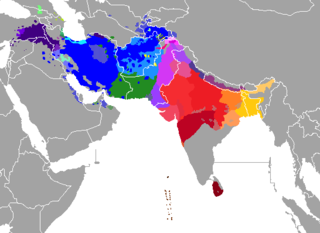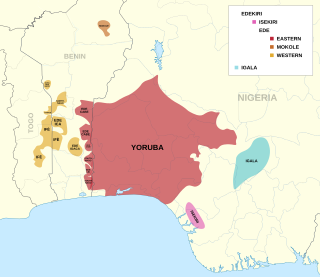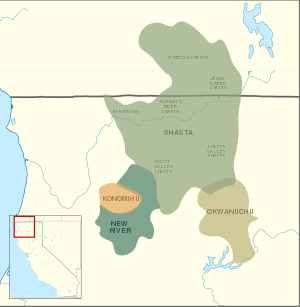
The Indo-Iranian languages constitute the largest and southeasternmost extant branch of the Indo-European language family. They include over 300 languages, spoken by around 1.5 billion speakers, predominantly in South Asia, West Asia and parts of Central Asia and Europe, comprising the modern-day countries of India, Pakistan, Bangladesh, Iran, Afghanistan, Nepal, Sri Lanka, Tajikistan, Maldives and the adjacent regions of neighbouring countries.
Shasta or Shastan may refer to:

The Hokan language family is a hypothetical grouping of a dozen small language families spoken mainly in California, Arizona, and Baja California.
The Achumawi language is the indigenous language spoken by the Pit River people in the northeast corner of present-day California. The term Achumawi is an anglicization of the name of the Fall River band, ajúmmááwí, from ajúmmá "river". Originally there were nine bands, with dialect differences primarily between upriver and downriver, demarcated by the Big Valley mountains east of the Fall River valley.

Wakashan is a family of languages spoken in British Columbia around and on Vancouver Island, and in the northwestern corner of the Olympic Peninsula of Washington state, on the south side of the Strait of Juan de Fuca.
Palaihnihan is a language family of northeastern California. It consists of two closely related languages, both now extinct:

The Yuman–Cochimí languages are a family of languages spoken in Baja California, northern Sonora, southern California, and western Arizona. Cochimí is no longer spoken as of the late 18th century, and most other Yuman languages are threatened.
The Okwanuchu were one of a number of small Shastan-speaking tribes of Native Americans in Northern California, who were closely related to the adjacent larger Shasta tribe.
The Shasta language is an extinct Shastan language formerly spoken from northern California into southwestern Oregon. It was spoken in a number of dialects, possibly including Okwanuchu. By 1980, only two first language speakers, both elderly, were alive. Today, all ethnic Shasta people speak English as their first language. According to Golla, there were four distinct dialects of Shasta:
The Shastan peoples are a group of linguistically related indigenous peoples from the Klamath Mountains. They traditionally inhabited portions of several regional waterways including the Klamath, Salmon, Sacramento and McCloud rivers. Shastan lands presently form portions of the Siskiyou, Klamath and Jackson counties. Scholars have generally divided the Shastan peoples into four languages, although arguments in favor of more or less existing have been made. Speakers of Shasta proper-Kahosadi, Konomihu, Okwanuchu, and Tlohomtah’hello "New River" Shasta resided in settlements typically near a water source. Their villages often had only either one or two families. Larger villages had more families and additional buildings utilised by the community.

Kalapuyan is a small extinct language family that was spoken in the Willamette Valley of Western Oregon, United States. It consists of three languages.

The Chimariko are an indigenous people of California, who originally lived in a narrow, 20-mile section of canyon on the Trinity River in Trinity County in northwestern California.

Chimariko is an extinct language isolate formerly spoken in northern Trinity County, California, by the inhabitants of several independent communities. While the total area claimed by these communities was remarkably small, Golla (2011:87–89) believes there is evidence that three local dialects were recognized: Trinity River Chimariko, spoken along the Trinity River from the mouth of South Fork at Salyer as far upstream as Big Bar, with a principal village at Burnt Ranch; South Fork Chimariko, spoken around the junction of South Fork and Hayfork Creek, with a principal village at Hyampom; and New River Chimariko, spoken along New River on the southern slopes of the Trinity Alps, with a principal village at Denny.

The Yuki–Wappo or Yukian languages are a small language family of western California consisting of two distantly related languages, both now extinct.

The Yana language is an extinct language that was formerly spoken by the Yana people, who lived in north-central California between the Feather and Pit rivers in what is now the Shasta and Tehama counties. The last speaker of the southernmost dialect, which is called Yahi, was Ishi, who died in 1916. When the last fluent speaker(s) of the other dialects died is not recorded. Yana is fairly well documented, mostly by Edward Sapir.

Yoruboid is a language family composed of the Igala group of dialects spoken in south central Nigeria, and the Edekiri group spoken in a band across Togo, Ghana, Benin and southern Nigeria, including the Itsekiri of Warri Kingdom.
Shasta traditional narratives include myths, legends, tales, and oral histories preserved by the Shasta people of northern California and southern Oregon.
Okwanuchu is an extinct Shastan language formerly spoken in northern California. Kroeber described the language as "peculiar. Many words are practically pure Shasta; others are distorted to the very verge of recognizability, or utterly different." Golla speculates at length that the language may have mixed in another, non-Shasta language. Du Bois, interviewing a survivor of a group that the Wintu called Waymaq, who she believed were probably identical to the Okwanuchu, recorded some words, including atsa ("water"). Golla writes that eighteen more words are found, under the name "Wailaki [also meaning 'North People'] on McCloud", in an 1884 work by Jeremiah Curtin; he too recorded atsa ("water"), and five words not found elsewhere in Shastan.
New River Shasta is an extinct Shastan language formerly spoken in northern California. It may have had only 300 speakers before contact, and they soon went extinct; the language is attested in only a few short wordlists. Kroeber regarded them as possibly "nearest to the major group in speech, although [...] their tongue as a whole must have been unintelligible to the Shasta proper."
Konomihu is an extinct Shastan language formerly spoken in northern California. There may have been only a few speakers even before contact, and they self-identified as Shasta by the turn of the 20th century.









